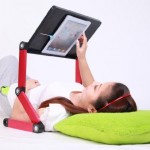Healthy Ergonomics for Touch-screen Tablets and Smartphones
In a study by Harvard School of Public Health, experienced tablet users completed a series of tasks using two types of touch-screen tablets. Each had a case that with adjustments that allowed for the units to adjust for tilt and be propped up. The findings reveal some simple, yet effective opportunities for healthy ergonomics.
Tablets, smartphones, and other touch-screen devices are fairly recent additions to technology. And those using tablets and smartphones are more likely to sit in a flexed posture.
When using a touch-screen device, the most important factor to consider is posture.
Here are a few suggestions to improve posture and work safely when using touch-screen devices:
- Place the touch-screen device on a higher surface, such as on a table rather than on your lap. When sitting on a couch, use a pillow or small box on your lap to support the device
- Laying on your back, with arms propped up may be a comfortable alternative
- Find a balance between a steep and low angle that allows for healthy and comfortable neck, shoulder, wrist and arm postures
- Those using touch-screen computer monitors (in traditional settings) occasionally may find themselves extending their arms to reach the screen and may need to move closer to the monitor so as to not overextend
- Take frequent breaks, including a 1-2 minutes stretch break every 30-60 minutes.
According to the findings, postures were at their healthiest when the “devices were set at their steepest angle;” however, the “steeper angles may be detrimental for tasks requiring your hands, such as typing a long email.” As reported in the study’s conclusion, “these data suggest that head and neck posture can be improved through case designs that allow for optimal viewing angles and elevating the device and avoiding lap-level locations.”
Touch-screen devices, tablets, and smartphones were designed for quick reference, entertainment, and to serve as a communications tool. Traditional keyboards and mouse devices (available for touch-screen devices) are the better choice if the device is being used for more traditional tasks such as email, spreadsheets, and other mouse and key intensive work.
Want to learn more:
Touch-screen tablet user configurations and case-supported tilt affect head and neck flexion: Study published in Journal of Prevention, Assessment, and Rehabilitation
Mobile Phones and Tablet Tips (University of California)
http://www.ucop.edu/risk-services/loss-prevention-control/ergonomics/ergo-mobile.html

